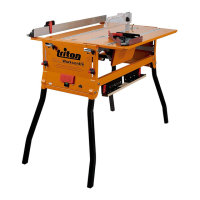ARBOR FLOAT
Page 14
A float-free arbor, and firm mountings between the motor and baseplate, are most important.
Check for arbor float as described above. To check the mountings, hold the baseplate down on a
flat surface, and see how much you can move the motor up and down. Test at different height and
angle settings.
Most circular saws have a height adjustment pivot at the front, with the locking lever/knob behind
the motor. They are the preferred type. Vertical lift (plunge-type) saws should only be fitted if they
remain rigid and accurate throughout their height and angle adjustment range.
A 235mm (9 1/4”) saw is best for heavy work, requiring a large depth of cut or extra power. 208mm
(8 1/4”) or 185mm (7 1/4”) saws are quite adequate. If considering upgrading your saw, the Triton
235mm Precision Power Saw is highly recommended.
SELECTING A SAW BLADE
This is one of the key factors for square, smooth cuts with a minimum of splintering. We strongly
recommend tungsten carbide tipped (TCT) blades.
Triton Premium TCT Saw Blades have been
expressly designed for the Workcentre and have a
unique tooth design. They cut very cleanly, reduce
arbor float-related problems, and minimise
splintering, especially in veneered boards.
The number of teeth depends on the work you’ll
mainly be doing: for crosscutting, the more teeth
the better. A 184mm saw should have 30 - 40 teeth
and a 235mm saw should have 40 - 60 teeth.
Ripping generally requires fewer teeth, (20 - 32 on a 235mm blade), with larger gullets behind the
teeth to help clear the longer curls of saw dust created when ripping natural timbers.
If you can only afford one blade, we suggest more teeth rather than fewer. Just slow down the feed
rate when ripping natural timbers.
Triton TCT Saw Blade Cut
Standard Saw Blade Cut
If your cuts have ridges, burn marks or high
spots , the saw is mounted skew on the
slide chassis, or it has arbor float, or the
blade is blunt / buckled. Check for arbor float
by unplugging, gripping the blade or blade
nut, and pulling in and out in the direction of
the shaft. Any movement is undesirable.
For perfectly square cuts, you may have to
repair or upgrade your saw.
You might reduce the problem by placing a
parallel-sided packer between your work and
the fence. Also try shaving cuts, where
the second (shaving) cut removes say 1 mm
of material, putting less load on the arbor.
SELECTING A CIRCULAR SAW
1 2
3 4
5
1
2
3
4
Packer

